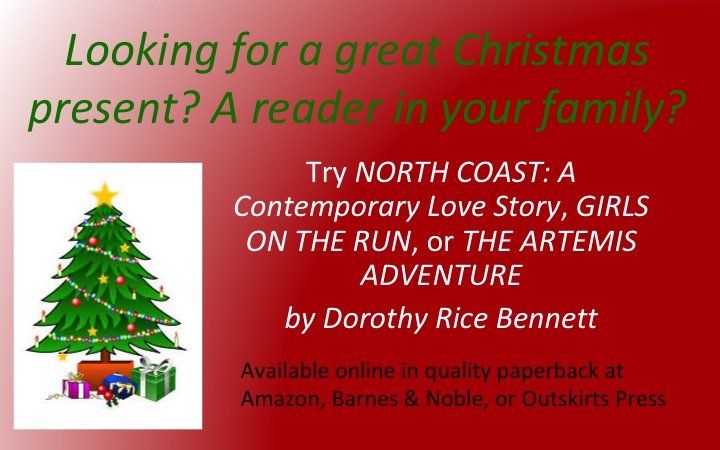
By Dorothy Rice Bennett
For anyone curious about my new novel, The Artemis Adventure, I’m attaching a draft from the first galley sent back to me by the publisher, Outskirts Press. There may be a small change or two from this galley to the finished book, but the essence of the story is here. This may give you some understanding of the book, my writing style, and hopefully entice you to want to read it.
Thanks for your interest!
1
Kiki’s Star
As Kiki lay on the warm rooftop and gazed skyward at the stars, she made up her mind. She was definitely leaving.
Her mama and papa were screaming at each other in the apartment two floors below. This ongoing marital battle erupted in semi-weekly yelling bouts, and Kiki needed to escape the uproar. She had learned that the best way to keep her own sense of balance was to come up the stairway to the roof, spread an old blanket, and lie down on her back. If she was lucky—and it was a clear night with minimal smog—she could see the moon and stars overhead.
Kiki was not an expert on astronomy. Although she didn’t know the official names for the star constellations, she loved looking up at the night sky. At first, her favorite star had been the really big, bright one that she could always spot even when she found it in a slightly different place. After she had spent months just lying still and focusing on its bright light—while lost in her own teenage fantasy world—she noticed a smaller star just down and to the right of the big one. This one seemed to blink at times. The star would disappear and then come back. Kiki decided, with a touch of amusement, that maybe this star was communicating with her.
Someone from Kiki’s high school had read a book about mythology and told her about a Greek goddess named Artemis. An archer who wandered through the forest in search of adventures, accompanied by her faithful dog, Artemis was strong and independent—kind of an outsider who acted on her own. Although Kiki had never seen a real bow and arrow in the South Bronx, and a dog would be a luxury in her family, she liked the idea of Artemis’s free spirit and named her blinking star after the goddess.
*****
Kiki had slipped away to the rooftop during the past several months, weather permitting, to have some privacy to think about her life. The Rodriguez apartment was crowded and cluttered, with six people sharing it—her three brothers as well as Kiki and their parents. At the moment there were only five, because her oldest brother Raul was serving time in prison. Besides that, Javier was seldom home, since he hung out with his gang, and Kiki feared that he would eventually end up dead or in prison as well.
A product of the American melting pot, Kiki bore the name Patricia Loretta Cristina Rodriguez. She felt like a Heinz-57 mutt, with her mostly Polish mother and her Puerto Rican-Filipino father. She was third among the family’s four children. Only Gusto was younger. With difficult and often-absent older brothers and an alcoholic father, Kiki had been forced to take care of herself at an early age. Her gut feeling was that lack of money and a chaotic upbringing—not to mention being a female—would make adult life very challenging.
Just turned eighteen, Kiki was five feet, two inches tall with an athletic build. She had large brown eyes that sparkled, wavy dark hair that fell to her shoulders—when not pulled into a ponytail—and an olive complexion. She was pretty, with full lips and two dimples that showed when she smiled. Kiki felt self-conscious about her nose, which seemed, to her, a bit too pug for her face, and she had a slight scar over one eye—a scar she had acquired when she hadn’t ducked soon enough as two brothers sparred with each other during a family fight.
Kiki had just finished her junior year in high school. One more year, she thought to herself, and you can start college and get out of this depressing world.
Kiki heaved a deep sigh. Yeah, what a dream. What chance did she have to go to college, really? She had worked for an elderly Jewish baker until he had a stroke and his store was closed. Now she couldn’t find another job, and the little savings fund she had spirited away for school kept shrinking instead of growing. No matter how creative she was in hiding her stash, Javier was smarter. When he needed drug money, he turned her room upside down until he found cash or something else he could sell. Kiki would scream at him and pound his shoulders with her fists, but he would just shrug her off, take her money, and nothing would change.
It seemed to Kiki that Mama and Papa’s fights were becoming worse, and with the sweltering days of summer upon them, they would be at it almost every night. Kiki was sure there was nowhere in the world more hot and humid than a South Bronx apartment in August.
She lay on the steamy roof and watched Artemis blinking at her and knew that it was time to do something. Scary as the thought was, it was time for her to leave. Out in the world, under those stars, there had to be someplace better than this. If she didn’t go now, she might never escape her family’s cycle of poverty and crime.
*****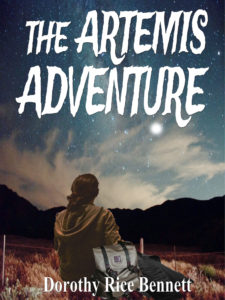
A door closed quietly nearby, and a familiar form dropped down beside her.
“I thought I’d find you here,” whispered Manuela. “I didn’t bother knocking on your door when I heard them yelling.”
The two teenage girls lay quietly for a moment, each watching the night sky. They had been best friends since grade school. They knew each other so well that they hardly needed words to read each other’s thoughts.
“Artemis is bright tonight,” Kiki finally commented, pointing her finger at the twinkling star low on the horizon.
“Yeah,” Manuela nodded, her chocolate brown eyes studying Kiki.
Kiki sighed. “I’m doin’ it,” she said. “I’m leaving.”
A look of pain crossed Manuela’s round face. “Really?”
Neither spoke for a long moment. “You wanna come?” Kiki finally offered.
“Oh, Kiki, I wish. But I got school and Ramon. I couldn’t run out on Ramon. I mean, he’s beginnin’ to talk marriage, an’ I—“
Kiki reached for Manuela’s bronze-skinned hand. “I know, Manuela. I just had to ask. You’re my best and dearest friend.”
The two girls continued to hold hands as they lay and looked upward, each one lost in thought. Kiki felt the soft warmth of Manuela’s larger paw. She would miss the reassurance of that hand.
*****
Aware that it was really late, Kiki stood up and pulled Manuela to her feet. The other girl towered over Kiki. They embraced for a long moment.
“I’ll miss you, Kiki,” Manuela whispered, as a tear slid down her cheek.
“Me, too. I’ll write when I can, okay?”
“Okay.”
Kiki opened the heavy metal door that led to the roof, and they walked carefully and quietly together down the dark, graffiti-scarred stairway to apartment 3A. They held each other once again briefly, and then—when Manuela had disappeared after waving a final goodbye—Kiki entered the dark and now blissfully silent apartment. Her papa had passed out drunk on the couch, and her mama had gone to bed. Kiki sighed with relief. Tonight might be easier than some.
Stepping inside her tiny bedroom, Kiki shut the door. Closing it made her personal space—which barely held a twin bed, dresser, and a small desk—even more sweltering than usual, but she needed privacy. She stretched out on her bed as the hint of a breeze puffed at the yellowed curtains hanging at her open window. Staring in nighttime dimness at the peeling paint on the ceiling, she attempted to make a plan. She would sleep, as much as she could, and then split in the morning. She’d take her money and her duffle bag and leave everything else, what there was of it. Thinking about Manuela—and being glad that her friend had stopped by so that one person knew she was about to leave yet wouldn’t tell—Kiki finally drifted off to sleep.
She awoke suddenly when the first hint of morning light crept through the cracked windowpanes. Rolling out of bed, Kiki hurriedly showered, and dressed. Then she began to pack. Pulling her PE duffle bag out of the closet, she tossed in her personal bathroom supplies. She added two changes of underwear, a couple of T-shirts, socks, a pair of shorts and some long pants, and a fleece hoodie. She laid a jacket on the bed. It was worn but made of soft black leather—something Javier had won in a gang squabble and then given to her because it was too small for him. Her heavy hiking boots sat on the floor; she would exchange her slippers for them when she was ready to leave.
Kiki threw the bag back into her closet and strolled out to the kitchen, acting as normally as she could manage. Mama was silent, nursing a black eye, and there was an air of tension about her from last night’s battle. She was fixing her usual breakfast of hash browns, which Mama made fresh and called “rosti,” along with beans, rice and tortillas for Papa.
Clearly hung over, Papa was smoking a cigarette and trying to absorb the morning paper. Javier apparently hadn’t come home again last night, because at the table there was just Gusto, who was barely fifteen.
Kiki pushed down anxiety as she seated herself and quietly studied everyone. She wanted to press their images into her memory, because she had no idea when she would see any of them again. There were things that maybe she should say, but words might create an alarm, and she didn’t want that, so she swallowed hard and kept silent.
Mama put the food on the table and commanded as usual, “Here, eat.”
Papa grunted and awkwardly juggled his newspaper, cigarette and fork. His eyes were fogged and watery.
Kiki sighed. Maybe slender, handsome Gusto, who dug into his beans and rice with a vengeance, still had possibilities. She hoped so, because he was a nice kid, yet she really wondered. She looked down at her plate of food but her stomach was tied in knots. Although she would need a good meal in her for the road, her mouth felt like cotton.
Mama turned from the stove, stared at Kiki and grunted. “Patricia Loretta Cristina Rodriquez, you eat! I’m not wastin’ good food.” She waved a finger menacingly in Kiki’s direction.
“Yes, Ma’am.” Kiki struggled to swallow a bite of hash browns.
Mama pointed at Javier’s empty chair. “Where’s Javier?”
Gusto looked up. “He ain’t home.”
Mama swore under her breath. “He’ll end up like his brother, rottin’ in a jail somewhere, if he don’t get knifed or shot first.”
There was silence, as they all tried to clean their plates. No one wanted to anger Mama and start another fight.
Finally, Kiki pushed away her chair. “Well, I’m gonna look for a job again today. So I better get going.”
Mama looked at her directly. Her eyes softened and a little smile crossed her face. “Good luck, baby.”
Kiki melted and rushed to be embraced in her mother’s fleshy arms. “I love you, Mama,” she said with tears in the corners of her eyes. Silently to herself, she admitted, “I’ll miss you, Mama.”
Papa grunted. “You better find somethin’ soon, bambina. Now you eighteen, you gonna hafta start payin’ rent around here. You got a whole bedroom, while the boys gotta share.”
Mama flared. “Shut it, Pablo. She knows what she’s gotta do.”
Kiki backed away from the tension and fled to her room, where she waited breathlessly. A few moments later, she heard her papa stand up and, with a heavy step, bang out the front door headed for work. Soon after that, Gusto followed on his way to summer school, and her mama soon left for her job in the meat market down the street. After the door shut for the last time, the apartment was quiet.
Huddled for a moment on her bed, feeling overwhelmed, Kiki struggled to pull herself together and remember her goal for the day. She had to get far enough away that they couldn’t come after her. She was of age, and she had the right to leave, but that wouldn’t stop her papa, or Javier, from coming to find her and forcing her to return home.
“You’d think they would be glad to see the last of me, since I’m just another mouth to feed,” she muttered aloud. “But, no, I’m part of the glue that holds this family together, so they want me here.” She sighed. It was time to live for herself, if she was ever going to have a life.
Kiki looked around the room at her favorite dolls, movie posters, and high school souvenirs that she might never see again. As she surveyed her life history, she thought of two other things she must take: her beat-up camera and a book of souvenir matches from the Waldorf Astoria Hotel. She might need matches for something, and the matchbook recalled one memory of something beautiful in New York.
Kiki wrote a vague note to her family—which they would find later in the day—saying she loved them and would be in touch. Then she emptied all her secret hiding places of her remaining savings, along with a Greyhound ticket from Newark to Pittsburgh that she had purchased in advance. She had figured out that non-express, slower buses were cheaper, so she had paid for the first leg of her trip. She sighed as she looked at her small roll of money and the ticket. This wasn’t much to get her to California.
*****
Kiki left the building, shouldering her duffle bag and jacket. Her pockets and boots were lined with cash. A slim wallet with her only identification was stuffed in a jeans pocket.
With her entire body a bundle of nerves, Kiki walked hesitantly to the nearest subway station. Going underground, she paid her fare to Penn Station. From there she would switch to a New Jersey line that would take her to Newark within an hour. She figured it was the quickest way out of New York. Once in Jersey, she could board the Greyhound headed west.
At a Penn Station kiosk, Kiki bought a bottle of water and a U.S. map. She felt dumb not to have thought of this before and picked up a map for nothing or next to nothing somewhere in the neighborhood, but it was too late now. Although Kiki trusted that the Greyhound would eventually get her to San Francisco, she was used to being in charge and wanted to have some idea where she was headed. Logically, she knew enough to keep the morning sun at her back when going west. Yet once the New York skyline was out of view, she would need more than Artemis to guide her—after all, her star was only visible at night, and then only on clear nights at that.
Kiki studied the map while she rode the subway, her stomach aching as each mile took her farther and farther away from the South Bronx, her family, and the only world she had ever known. Looking at the map kept her from staring too much at the strangers around her, but she soon noticed they, too, were focused on books, newspapers, cell phones, and not each other.
At one stop, two women got on the subway together, giggling. Then they threw their arms around each other and kissed. Noticing them out of the corner of her eye, Kiki blushed and buried herself more deeply in her map. Then she found herself—she didn’t know why—glancing at them as they stood arm in arm talking and laughing as the train hurled itself with jerking motions through the underground tunnel.
When she reached her New Jersey stop and left the subway station, Kiki surveyed the buildings around her and recognized how different everything looked and that she was standing on totally strange turf. Her heart began to pound in her ears. Calm down, she told herself. It was too late to be sorry that she had started this big adventure, but she was now feeling very unsettled. She had heard people were nicer and more helpful out West. Yet before she would reach California, she had days and nights to endure on a bus. Feeling waves of fear pass through her body, Kiki suddenly realized that despite her macho tomboy exterior, inside she was really a kitten. And right now a scared one at that.
Nervously taking deep breaths, Kiki strode toward the Greyhound Station.
Copyright 2018 by Dorothy Rice Bennett. Published October 7, 2017, by Outskirts Press. Available at Amazon.com, Barnes and Noble online, and Outskirts Press. Quality paperback, 315 pages, $17.95. Available locally in Sequim, Washington, through the author.



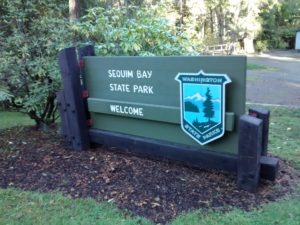 Silverdale and with my two toy poodles in the car, I slowed down in time, pulled off the highway and entered the park. The dogs became excited, as well they should. Wonderful smells awaited them.
Silverdale and with my two toy poodles in the car, I slowed down in time, pulled off the highway and entered the park. The dogs became excited, as well they should. Wonderful smells awaited them.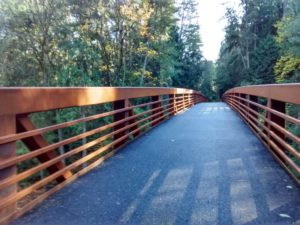 Peninsula to Forks and the Pacific Ocean. The section that cuts through our state park is open all the way through Sequim and on to Port Angeles. The asphalt-covered trail supports walkers, hikers, cyclists, strollers, wheelchairs, dogs on leashes, and anything that moves but doesn’t have an engine, so no motorcycles or autos.
Peninsula to Forks and the Pacific Ocean. The section that cuts through our state park is open all the way through Sequim and on to Port Angeles. The asphalt-covered trail supports walkers, hikers, cyclists, strollers, wheelchairs, dogs on leashes, and anything that moves but doesn’t have an engine, so no motorcycles or autos.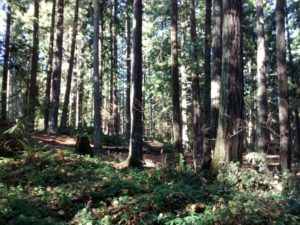 sites, some very near the water. (Some hookup sites were recently removed to make the remaining sites more spacious.) There are covered shelters, one with electricity, along with covered and uncovered picnic tables. There are benches and trails. A lighted underpass beneath the highway leads to ball fields and tennis courts on the south side of the 101. In the main park, I found swings and horseshoe pits.
sites, some very near the water. (Some hookup sites were recently removed to make the remaining sites more spacious.) There are covered shelters, one with electricity, along with covered and uncovered picnic tables. There are benches and trails. A lighted underpass beneath the highway leads to ball fields and tennis courts on the south side of the 101. In the main park, I found swings and horseshoe pits.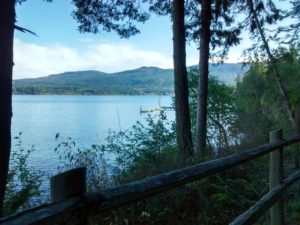 The park looks out on Sequim Bay with beautiful views from two shoreline paths, one with a boat launch and the second with a boat dock. The long dock accommodates several boats at a time, and the park is popular with fishing craft during designated fishing seasons; offshore moorage is also available. The park has 4,099 feet of saltwater coast on Sequim Bay, but coastal erosion has unfortunately eliminated access to some of the park’s beachfront areas.
The park looks out on Sequim Bay with beautiful views from two shoreline paths, one with a boat launch and the second with a boat dock. The long dock accommodates several boats at a time, and the park is popular with fishing craft during designated fishing seasons; offshore moorage is also available. The park has 4,099 feet of saltwater coast on Sequim Bay, but coastal erosion has unfortunately eliminated access to some of the park’s beachfront areas. In Sequim, check Walmart and Brian’s Sporting Goods. The park is open throughout the year, 8 a.m. until dusk.
In Sequim, check Walmart and Brian’s Sporting Goods. The park is open throughout the year, 8 a.m. until dusk.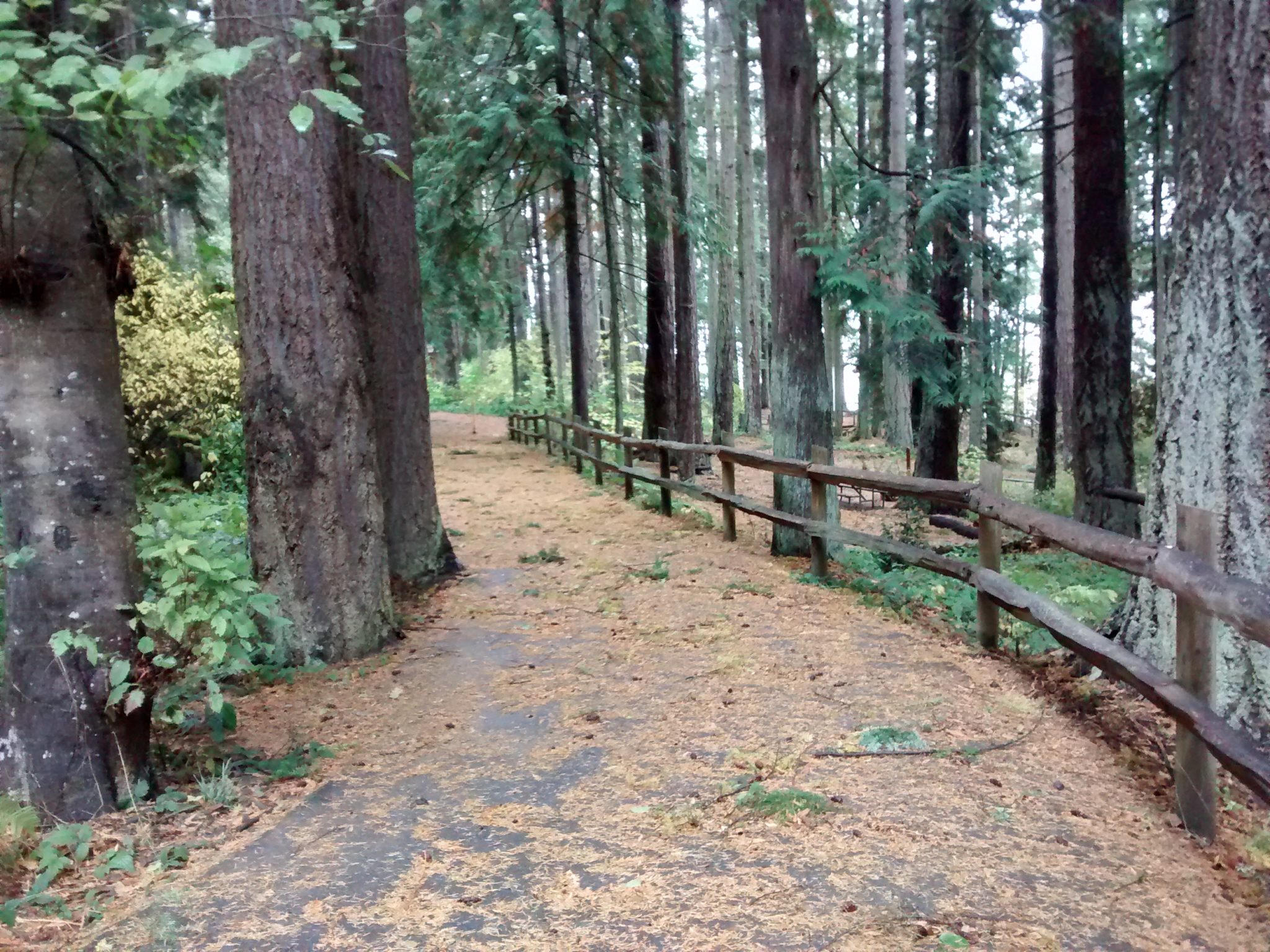


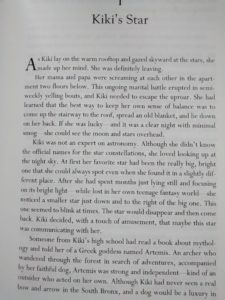
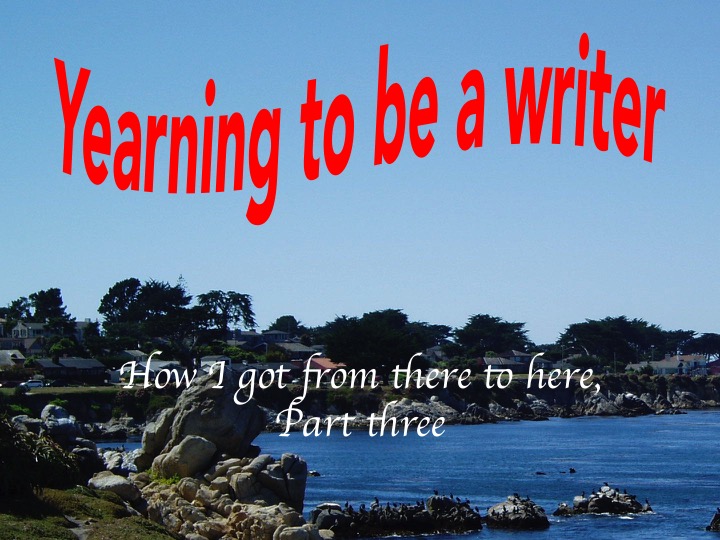
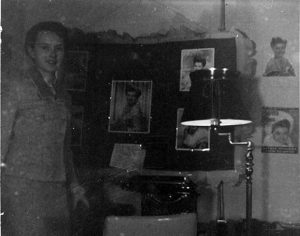 So I did. I bought a used AB Dick mimeograph and learned to type (thirty words a minute with one finger and a thumb), made stencils, and published in my basement “office” my own fan club journals, thirty pages long with pictures of Esther and my various guest stars, including Mitzi Gaynor, whom I later had the chance to meet. I then assembled and mailed the journals to my 150 members. It was a fun hobby, and I gradually learned that many adults did the same thing—some of them weren’t so happy when at fifteen I accepted an award for most active fan club of 1957 in New York City, from a fan club organization. At the awards dinner, I met actor Robert Evans and Hollywood columnist Rona Barrett, both early in their respective careers, and also one of my club members, Nancy Schiffmacher, from East
So I did. I bought a used AB Dick mimeograph and learned to type (thirty words a minute with one finger and a thumb), made stencils, and published in my basement “office” my own fan club journals, thirty pages long with pictures of Esther and my various guest stars, including Mitzi Gaynor, whom I later had the chance to meet. I then assembled and mailed the journals to my 150 members. It was a fun hobby, and I gradually learned that many adults did the same thing—some of them weren’t so happy when at fifteen I accepted an award for most active fan club of 1957 in New York City, from a fan club organization. At the awards dinner, I met actor Robert Evans and Hollywood columnist Rona Barrett, both early in their respective careers, and also one of my club members, Nancy Schiffmacher, from East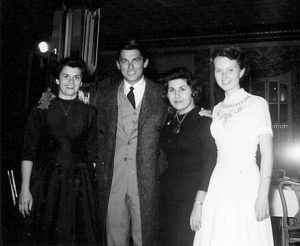 Hempstead, Long Island, New York.
Hempstead, Long Island, New York.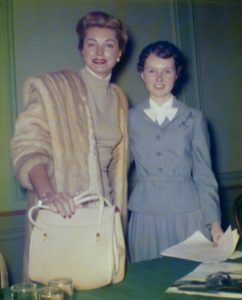 from her pool company in New York. I was allowed to spend two days touring Indianapolis with Esther and learned a lot about her. Of course, being fifteen, I couldn’t believe my good fortune. Among the activities that happened during those two days was an interview with Esther for high school journalists that I hosted in a downtown hotel. Some nice stories in local school papers came out of that interview. Despite the fun and excitement, I felt I didn’t know enough, or have the perspective, to write an adult piece about my relationship with Esther. I turned out a few pages and quit. Not me, not yet, anyway.
from her pool company in New York. I was allowed to spend two days touring Indianapolis with Esther and learned a lot about her. Of course, being fifteen, I couldn’t believe my good fortune. Among the activities that happened during those two days was an interview with Esther for high school journalists that I hosted in a downtown hotel. Some nice stories in local school papers came out of that interview. Despite the fun and excitement, I felt I didn’t know enough, or have the perspective, to write an adult piece about my relationship with Esther. I turned out a few pages and quit. Not me, not yet, anyway.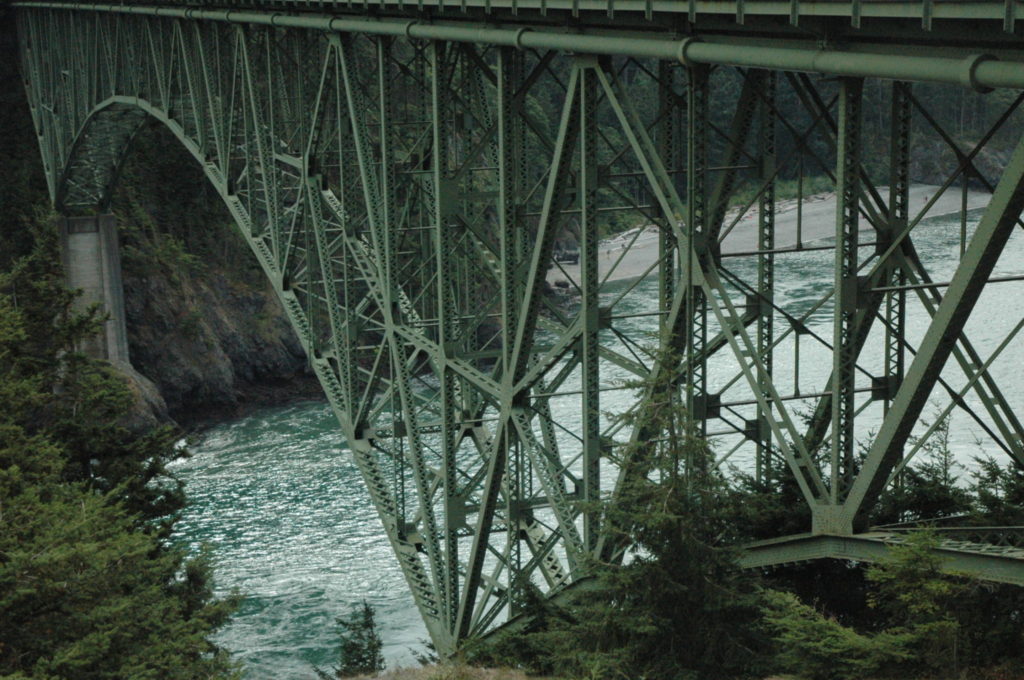
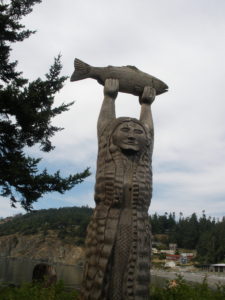 southwest Fidalgo Island.
southwest Fidalgo Island.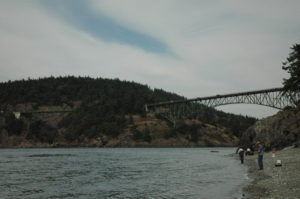 The picturesque bridges are now listed on the National Register of Historic Places. Photographers love the fact that these bridges are equipped with pedestrian walking paths, but if you have a touch of vertigo, the vibrations of automobiles just inches away and the rushing waters below could prove a challenge!
The picturesque bridges are now listed on the National Register of Historic Places. Photographers love the fact that these bridges are equipped with pedestrian walking paths, but if you have a touch of vertigo, the vibrations of automobiles just inches away and the rushing waters below could prove a challenge!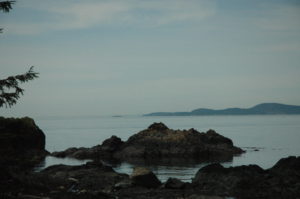 Rosario Beach is located on Fidalgo Island, at the western edge of Deception Pass State Park; it contains sandy beaches, a peaceful place for picnicking, tide pools to explore, and photo ops including The Maiden of Deception Pass story pole, based on Samish legend. Rosario Beach largely faces the Strait of Juan De Fuca and nearby islands, but trails toward Bowman Bay allow vistas of Whidbey Island and Deception Pass. Ancient trees provide bald eagle perches, and the waters close to the beach and tide pools offer amazing examples of sea life at low tides. Whales and porpoises have been seen in the waters to the west.
Rosario Beach is located on Fidalgo Island, at the western edge of Deception Pass State Park; it contains sandy beaches, a peaceful place for picnicking, tide pools to explore, and photo ops including The Maiden of Deception Pass story pole, based on Samish legend. Rosario Beach largely faces the Strait of Juan De Fuca and nearby islands, but trails toward Bowman Bay allow vistas of Whidbey Island and Deception Pass. Ancient trees provide bald eagle perches, and the waters close to the beach and tide pools offer amazing examples of sea life at low tides. Whales and porpoises have been seen in the waters to the west.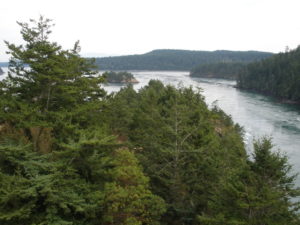 turn before going through. From Sequim, there is an opportunity to transit the pass with an experienced licensed captain, Charles Martin, who keeps his tour boat at the John Wayne Marina and offers a Deception Pass tour through the Shipley Center in Sequim.
turn before going through. From Sequim, there is an opportunity to transit the pass with an experienced licensed captain, Charles Martin, who keeps his tour boat at the John Wayne Marina and offers a Deception Pass tour through the Shipley Center in Sequim.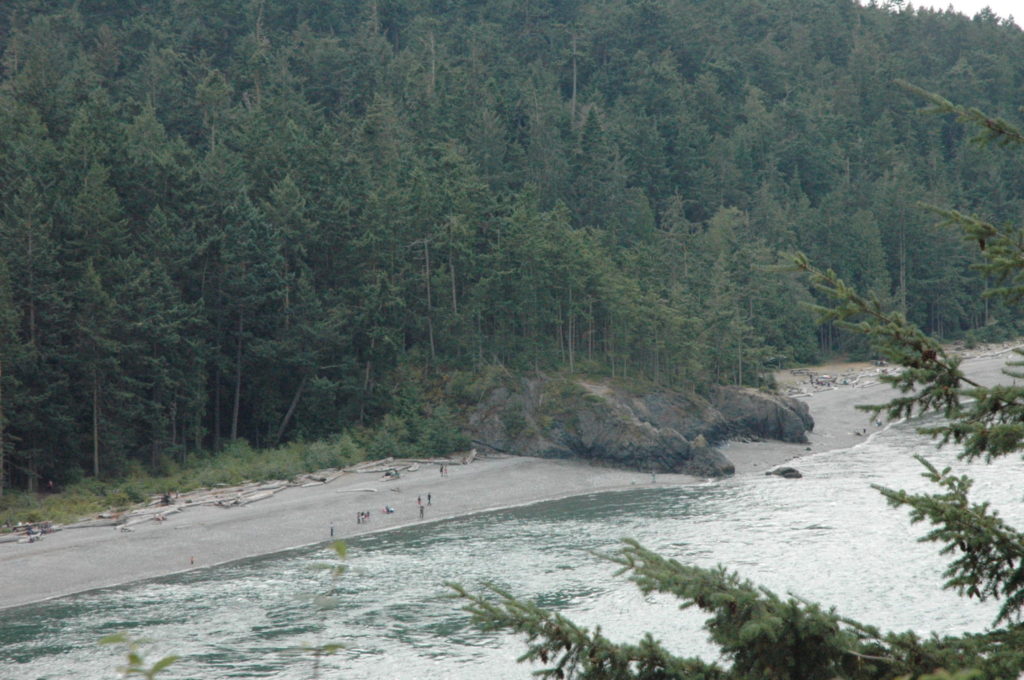
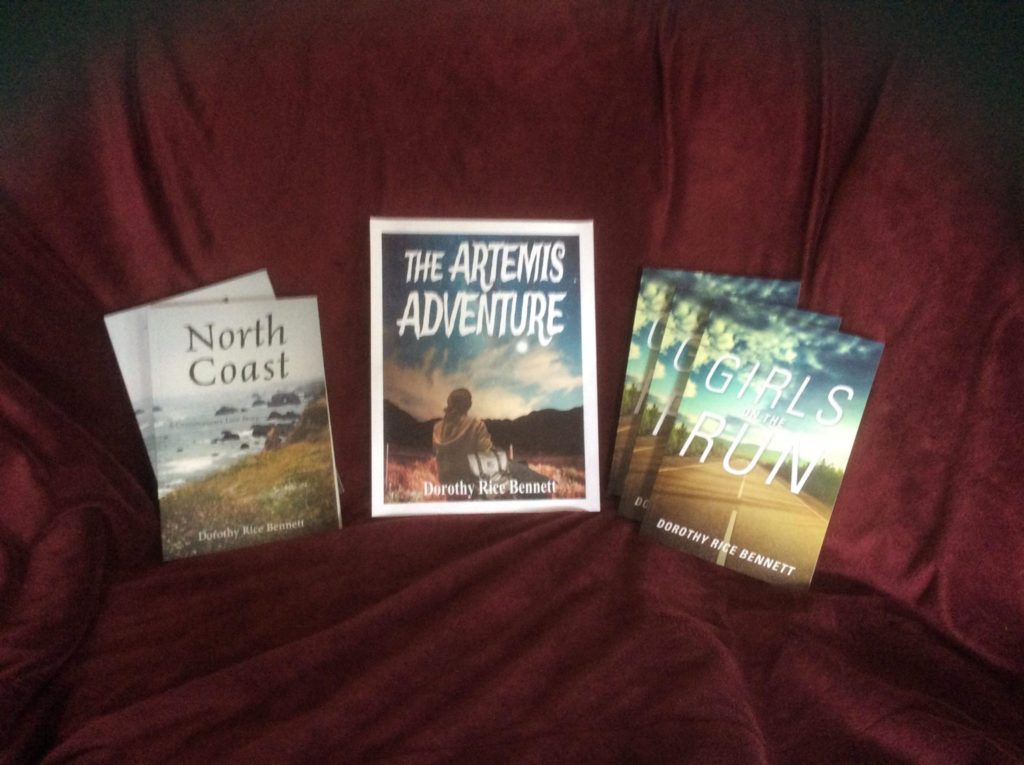
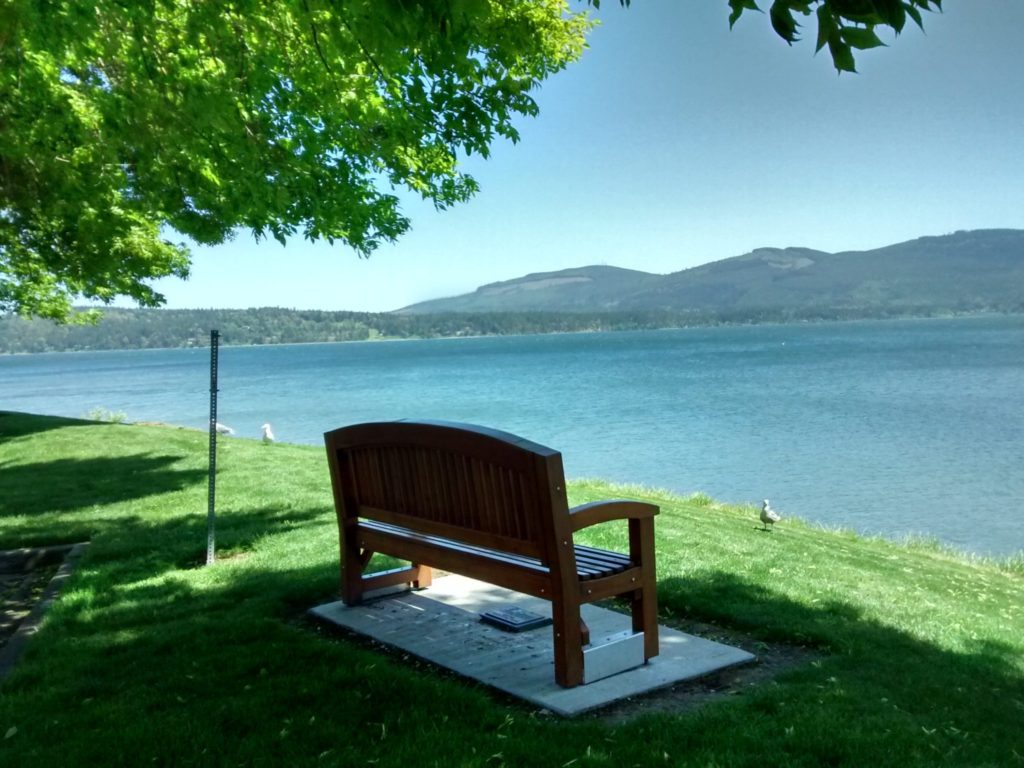 By Dorothy Rice Bennett
By Dorothy Rice Bennett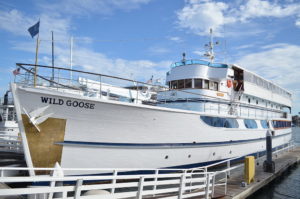
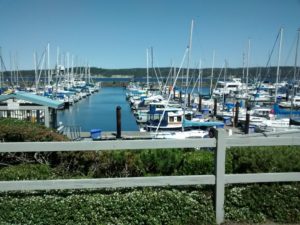 Today the John Wayne Marina remains a jewel of the Olympic Peninsula. Located on a lovely and quiet bay, protected by an attractive berm, the marina provides rental slips, guest docks, launch ramps, rest rooms, laundry facilities, and showers. There is also a restaurant, Dockside Grill, on site, banquet rooms, and the Sequim Bay Yacht Club. Rental kayaks and canoes are available at the guest docks, along with fuel supplies. The marina was featured in the June 2003 issue of SEA Magazine’s “Best of the West” for small marinas.
Today the John Wayne Marina remains a jewel of the Olympic Peninsula. Located on a lovely and quiet bay, protected by an attractive berm, the marina provides rental slips, guest docks, launch ramps, rest rooms, laundry facilities, and showers. There is also a restaurant, Dockside Grill, on site, banquet rooms, and the Sequim Bay Yacht Club. Rental kayaks and canoes are available at the guest docks, along with fuel supplies. The marina was featured in the June 2003 issue of SEA Magazine’s “Best of the West” for small marinas.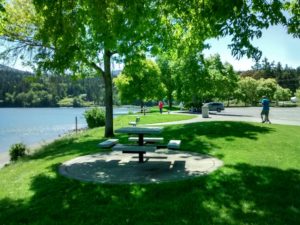
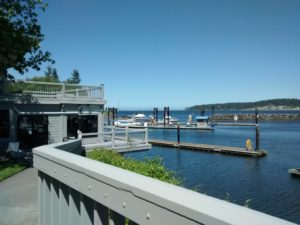 During the daytime, docks are open to the public, and walking the slips, it is possible to find all kinds of power and sailing vessels from many homeports, including Capt. Martin’s catamaran that takes visitors on local sightseeing trips. There is also a research hatchery floating dock. Large fishing boats from Alaska and Asia appear occasionally at the guest docks. One day a woman and a man pedaled around the marina in a small fold-up trimaran sailing craft. You just never know what you are going to see.
During the daytime, docks are open to the public, and walking the slips, it is possible to find all kinds of power and sailing vessels from many homeports, including Capt. Martin’s catamaran that takes visitors on local sightseeing trips. There is also a research hatchery floating dock. Large fishing boats from Alaska and Asia appear occasionally at the guest docks. One day a woman and a man pedaled around the marina in a small fold-up trimaran sailing craft. You just never know what you are going to see.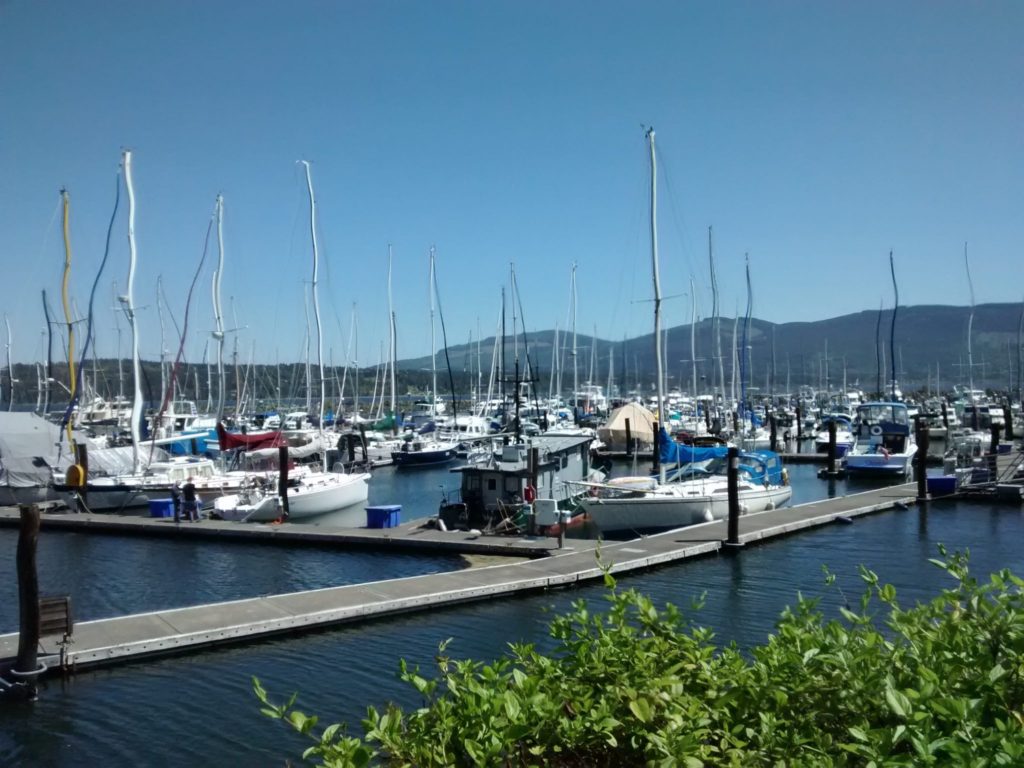

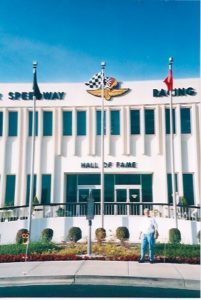 were “midgets,” smaller racing machines that performed on a regular basis at a half-mile oval across the street from the monster Indy track. But Kepler’s Garage also drew a few Indy cars. Kids from my neighborhood—several boys and me—would pass by that open-door garage and we would wander in to look closely at the race cars. The mechanics were patient with our youthful enthusiasm and would explain a thing or two before shooing us out the door in order to get their work done. We all imagined being race drivers one day (even me, a girl). Who wouldn’t? These were the celebrities of our world.
were “midgets,” smaller racing machines that performed on a regular basis at a half-mile oval across the street from the monster Indy track. But Kepler’s Garage also drew a few Indy cars. Kids from my neighborhood—several boys and me—would pass by that open-door garage and we would wander in to look closely at the race cars. The mechanics were patient with our youthful enthusiasm and would explain a thing or two before shooing us out the door in order to get their work done. We all imagined being race drivers one day (even me, a girl). Who wouldn’t? These were the celebrities of our world.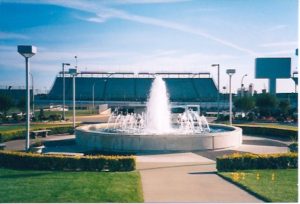 tured jet aircraft engines. On one side of Main Street were small commercial businesses—the A&P, a movie house, a corner grill, drugstores, beauty shops, etc. On the opposite side were industrial firms, Esterline-Angus, Union Carbide, and so on. These businesses were officially inside Speedway, which received tax proceeds from them, benefiting our community and school district.
tured jet aircraft engines. On one side of Main Street were small commercial businesses—the A&P, a movie house, a corner grill, drugstores, beauty shops, etc. On the opposite side were industrial firms, Esterline-Angus, Union Carbide, and so on. These businesses were officially inside Speedway, which received tax proceeds from them, benefiting our community and school district.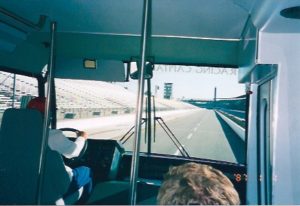 our yard with cars on race day. Going price was 50 cents (now it’s probably $20). I made signs and stood at the end of our alley and directed cars to the gates of our back yard. A friend shoed the cars into the yard, and my father watched that they parked without blocking one another. That first year, I filled the back yard, the front yard, and the driveway with vehicles and made several bucks for myself.
our yard with cars on race day. Going price was 50 cents (now it’s probably $20). I made signs and stood at the end of our alley and directed cars to the gates of our back yard. A friend shoed the cars into the yard, and my father watched that they parked without blocking one another. That first year, I filled the back yard, the front yard, and the driveway with vehicles and made several bucks for myself.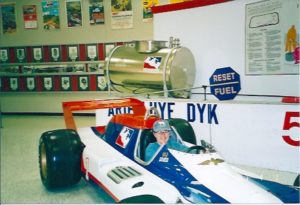 but not Indy out of the girl. I’ve always been a fan of beautiful and fast cars. My greatest thrill was having two Toyota Supras in the 1980s, definitely sporty, definitely fun to drive, and definitely satisfying to the Indy fan in me.
but not Indy out of the girl. I’ve always been a fan of beautiful and fast cars. My greatest thrill was having two Toyota Supras in the 1980s, definitely sporty, definitely fun to drive, and definitely satisfying to the Indy fan in me.
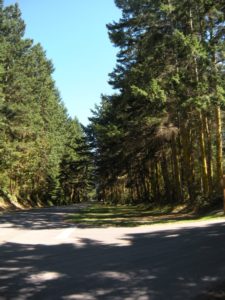 Fort Flagler Historical State Park on Marrowstone Island, east of Port Townsend and the Olympic Peninsula. From Sequim it’s just about an hour’s drive through evergreens, rural areas, small communities, and water views. We load up the CR-V with sandwiches or chicken and goodies, and take the dogs. They love it. I bring along a baseball and a couple of gloves for a session of pitch and catch along the beach.
Fort Flagler Historical State Park on Marrowstone Island, east of Port Townsend and the Olympic Peninsula. From Sequim it’s just about an hour’s drive through evergreens, rural areas, small communities, and water views. We load up the CR-V with sandwiches or chicken and goodies, and take the dogs. They love it. I bring along a baseball and a couple of gloves for a session of pitch and catch along the beach.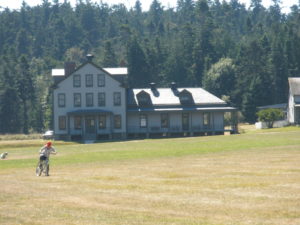 attack. Built in the late 1890s, Fort Flagler was manned during World Wars I and II and the Korean War. Numerous gun emplacements are still intact and can be explored independently or through tours provided during summer months.
attack. Built in the late 1890s, Fort Flagler was manned during World Wars I and II and the Korean War. Numerous gun emplacements are still intact and can be explored independently or through tours provided during summer months.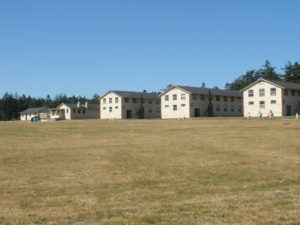 hospital open for tours from Memorial Day through Labor Day (check dates and times before going). The Coast Guard maintains a station and simple lighthouse at the northernmost tip of Marrowstone Island; these are not open to the public but are approached via the park.
hospital open for tours from Memorial Day through Labor Day (check dates and times before going). The Coast Guard maintains a station and simple lighthouse at the northernmost tip of Marrowstone Island; these are not open to the public but are approached via the park. with bleached logs and other pieces of driftwood. It’s illegal to remove the driftwood, but visitors have fun playing with the pieces and building structures from them. From that beach there are particularly beautiful views of snow-covered Mt. Baker to the north.
with bleached logs and other pieces of driftwood. It’s illegal to remove the driftwood, but visitors have fun playing with the pieces and building structures from them. From that beach there are particularly beautiful views of snow-covered Mt. Baker to the north.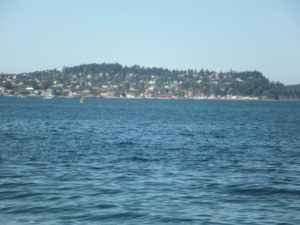
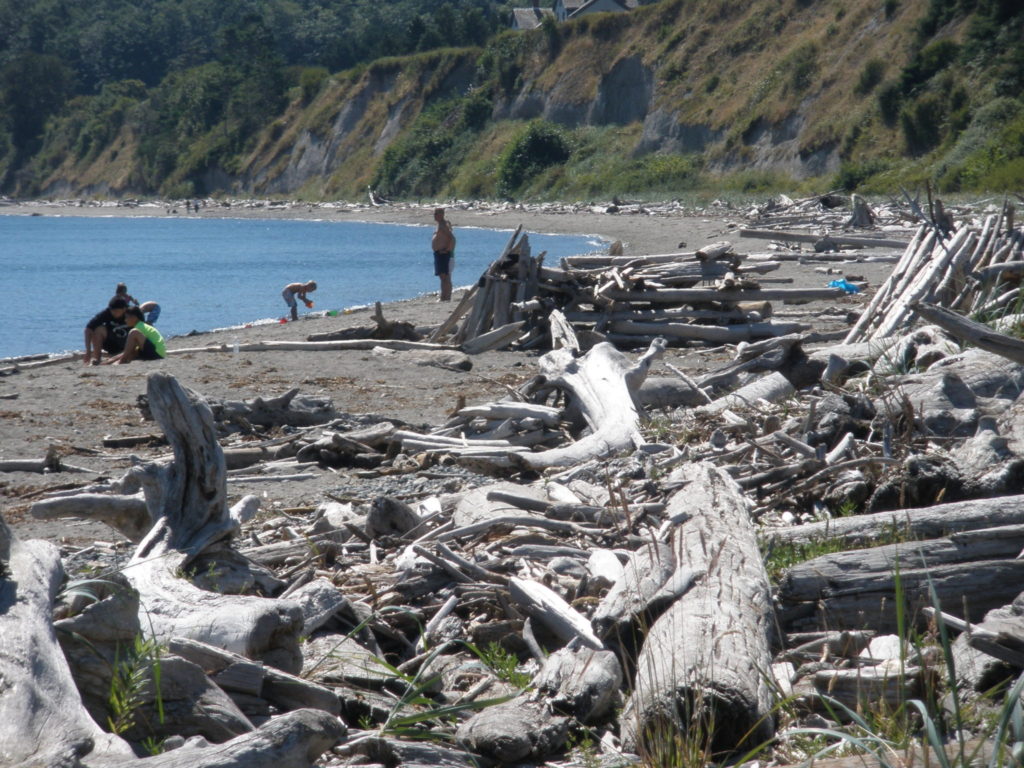
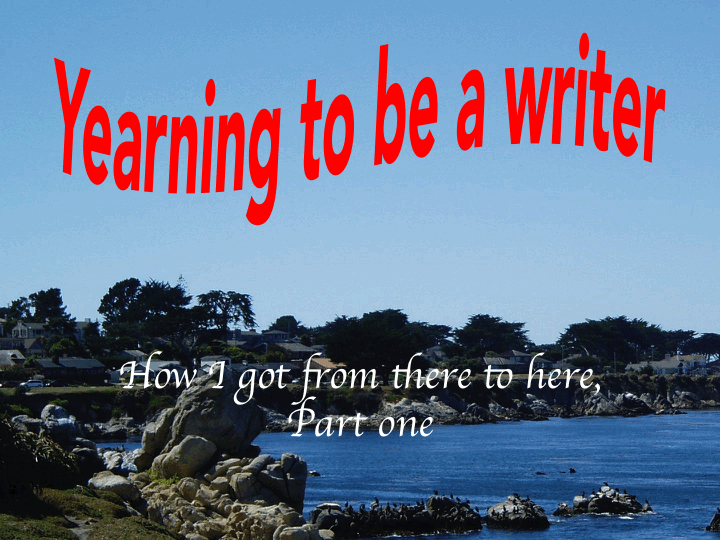
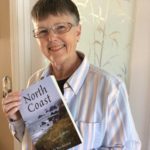 in the genes. It’s inherited from parents and grandparents—even if the only thing those forerunners did was assemble a grocery list or write names in the family Bible. Beyond the DNA, the writing gene is modified by life experiences. Since the only life experience I truly know—and halfway understand—is my own, I have to start there.
in the genes. It’s inherited from parents and grandparents—even if the only thing those forerunners did was assemble a grocery list or write names in the family Bible. Beyond the DNA, the writing gene is modified by life experiences. Since the only life experience I truly know—and halfway understand—is my own, I have to start there.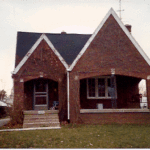 I was born. I was a challenge, probably more than they had realized. Thanks to the stresses created by an active toddler, they separated for three months when I was barely three. My mother took me by train in the summer of 1945 to Wenatchee, Washington, to see her family and give my father time to think. After numerous pleading letters, Mother and I went home. Their marriage was not made in Heaven but with a few relapses (and episodes of the Bickersons) they stayed the course for more than fifty years, until my mother died.
I was born. I was a challenge, probably more than they had realized. Thanks to the stresses created by an active toddler, they separated for three months when I was barely three. My mother took me by train in the summer of 1945 to Wenatchee, Washington, to see her family and give my father time to think. After numerous pleading letters, Mother and I went home. Their marriage was not made in Heaven but with a few relapses (and episodes of the Bickersons) they stayed the course for more than fifty years, until my mother died. cowboy hats, western shirts, and cap pistols. There were lots of boys in the neighborhood and only one girl, who shortly moved away. So I played Army and touch football and built forts in the back yard. My dad took me to Indianapolis Indians baseball games and played pitch and catch with me. I had a bat, ball and glove.
cowboy hats, western shirts, and cap pistols. There were lots of boys in the neighborhood and only one girl, who shortly moved away. So I played Army and touch football and built forts in the back yard. My dad took me to Indianapolis Indians baseball games and played pitch and catch with me. I had a bat, ball and glove.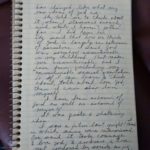 scripts in narrative form. My characters were drawn from the movies I had seen and the actors and actresses that I admired. I loved writing, because I could make up my world the way I thought it ought to be, instead of the way it really was.
scripts in narrative form. My characters were drawn from the movies I had seen and the actors and actresses that I admired. I loved writing, because I could make up my world the way I thought it ought to be, instead of the way it really was.